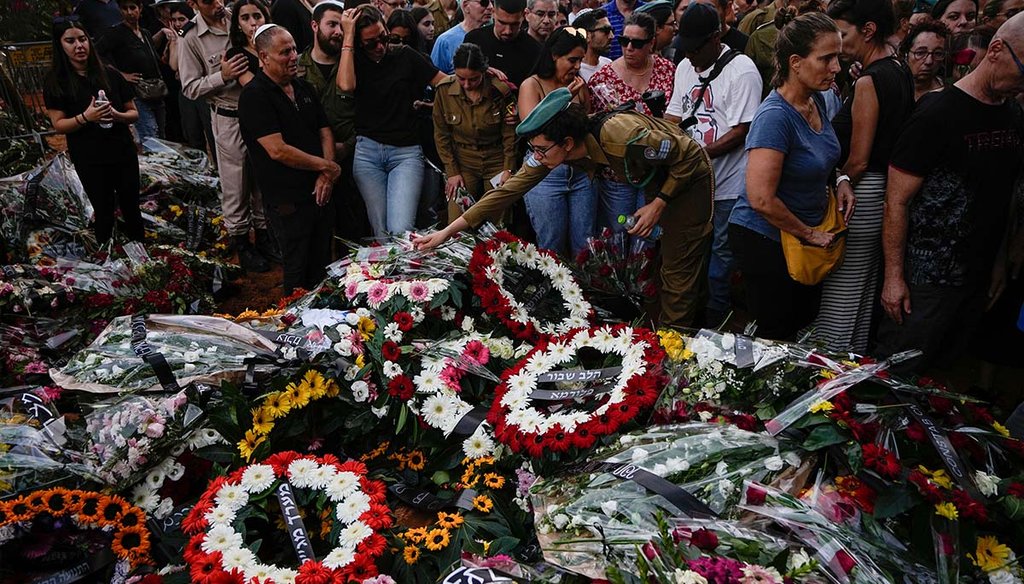Editor’s note: This story contains references and links to graphic images and videos. The story is a revised version of one we published Oct. 20. We corrected and recast that story following an article by the Center for Accuracy in Middle East Reporting and Analysis. See this note from our editor-in-chief for more explanation.
More than a month into the Israel-Hamas war, footage and firsthand accounts lay bare the atrocities caused by the fighting.
During Hamas’ Oct. 7 attack on Israel, militants raided communities and a music festival, killing more than 1,200 people, including children, and taking 240 more as hostages, Israeli authorities said.
Israel’s subsequent attacks on Gaza have killed more than 11,000 people, a majority of them women and children, according to the Gaza-based Health Ministry, which is part of the Hamas-controlled government and the only official source for casualties in the territory. The Health Ministry said the death toll has increased, but as of Nov. 10 it could no longer provide updates on casualties because of communications outages, The Washington Post reported.
Amid bloodshed and devastation, reports of Hamas militants beheading babies rose to prominence in the news and on social media.
With conflicting reports from officials and media on the ground, journalists without access to the area and local autopsy or medical records struggle to independently verify accounts. Israeli officials have not released footage of beheaded babies, unlike other documentary evidence of gruesome acts on Oct. 7. In the weeks since, several Israeli military officials and witnesses have maintained that they saw babies without heads, using the word “beheaded” or “decapitated.”
PolitiFact examined the origins of reports that babies were beheaded, including how the Israeli military has discussed local reports, how political leaders in the United States and Israel addressed it, and how a more specific narrative about “40 beheaded babies” spread.
Early mentions of the claim
On Oct. 10, three days after Hamas’ attack on Kibbutz Kfar Aza in southern Israel, the Israel Defense Forces allowed news outlets to report from the site. Reporter Nicole Zedeck of i24 News, an Israeli news channel, said Israeli soldiers told her infants had been killed in the attack.
“The Israeli military still says they don’t have a clear number (of the casualties), but I’m talking to some of the soldiers, and they say what they’ve witnessed is they’ve been walking through these different houses, these different communities — babies, their heads cut off. That’s what they said,” Zedeck said during her broadcast from Kfar Aza.
Similarly, reporter Margot Haddad of the French news channel LCI posted Oct. 11 on X that Israeli soldiers told her babies had been beheaded in Kfar Aza. Other reporters on the ground in Kfar Aza from CNN, +972 Magazine and Le Monde said they either did not see evidence of beheaded babies in that location or were unable to confirm the report.
Hamas has denied allegations that its militants beheaded children and attacked women. CNN reported Oct. 11 that Hamas spokesperson and senior official Izzat al-Risheq said these reports “spread lies about our Palestinian people and the resistance” and that there was “no evidence to support such claims and lies.”
Multiple news outlets have reported that women and children were among the people killed or taken hostage in Hamas’ surprise attack.
How the Israeli military addressed reports of beheadings
When we inquired with the Israel Defense Forces North American Media Desk, we received a statement Oct. 12 that said women, children, toddlers and older people were “brutally butchered” in Kfar Aza during Hamas’ attack.
Israel Defense Forces spokesperson Jonathan Conricus said in an Oct. 11 broadcast on X that, based on reports, he could say “with relative confidence” that babies were beheaded in Kibbutz Be’eri, about 10 miles southwest of Kfar Aza. He said these reports came from eyewitnesses and an Oct. 11 CBS News interview with Yossi Landau, the southern region’s head of operations for Zaka, Israel’s civilian emergency response organization.
Landau’s accounts to news outlets about the attack’s aftermath have varied, and it’s unclear from these interviews where Landau saw mutilated bodies. In an Oct. 17 interview with CNN, Landau said he saw a teenager who had been beheaded. To India’s Republic World on Oct. 13, he described Hamas “chopping off the heads” of children. To Fox News on Oct. 17, he described extreme violence, some of which involved children, without specifically mentioning beheadings. In a Hebrew-language interview with Now 14 Israel, Landau said he picked up bodies of children and babies without heads.
PolitiFact contacted Zaka about Landau’s account but did not hear back before publication.
A third Israel Defense Forces spokesperson, Major Libby Weiss, told CBS News on Oct. 11 that Israeli soldiers reported finding in Kfar Aza “beheaded children of varying ages, ranging from babies to slightly older children,” along with adults who had been dismembered.
A spokesperson with the Israel Defense Forces’ North American Media Desk told PolitiFact on Nov. 13 that Conricus and Weiss were accurate in their statements.
Col. Golan Vach, head of the Israeli military’s search and rescue unit, told The New York Times, NBC News and AFP that he saw one decapitated baby in Be’eri. Col. Haim Weisberg, head rabbi of the Israel Defense Forces, has echoed these accounts of beheadings in interviews with NPR, Jewish Insider and The Daily Mail.
The Israel Defense Forces has shown some journalists footage of Hamas’ attack, compiled from cellphones, body cameras and surveillance systems, The Associated Press, ABC News and CNN reported. While viewing the footage, journalists were not allowed to record or access their phones.
ABC News reported that the footage its reporters viewed did not show beheaded babies. An unnamed Israeli military official told ABC that such images existed, but would not be shown to journalists or the public.
How Israeli and U.S. officials talked about the claim
Political leaders in Israel and the U.S. have publicly discussed the reports of beheaded babies. Their statements have not always aligned.
On Oct. 11, a spokesperson for Israeli Prime Minister Benjamin Netanyahu told CNN that babies and toddlers were found in Kfar Aza with their “heads decapitated.” The next morning, CNN cited an unnamed Israeli official who told the network that the Israeli government could not confirm the claim.
President Joe Biden also mentioned the report of beheaded babies during an Oct. 11 roundtable with Jewish leaders, saying, “I never really thought that I would see and have confirmed pictures of terrorists beheading children.”
The White House later told CNN that Biden had neither seen photos nor received confirmation that Hamas beheaded babies or children. Biden was referring to reports from media outlets and public comments by Israeli officials.
A week later in Israel, Biden described, “Children slaughtered. Babies slaughtered. Entire families massacred. Rape, beheadings, bodies burned alive.”
During a Nov. 15 press conference, Biden referred to beheadings a third time: “Hamas has already said publicly that they plan on attacking Israel again like they did before, to where they were cutting babies’ heads off to burn — burning women and children alive.”
Secretary of State Antony Blinken said Oct. 12 that Israeli officials had shown him documentation of “an infant riddled with bullets, soldiers beheaded, young people burned alive.”
During Blinken and Biden’s visits to Israel on Oct. 12 and Oct. 18, respectively, Netanyahu said Hamas beheaded people. He did not specify whether the victims were infants.
The Israeli prime minister’s office on Oct. 12 shared on X photos of babies it said were “murdered and burned” by Hamas. White House National Security Council Spokesperson John Kirby said the same day that there was no reason to doubt the authenticity of these images since they came from the prime minister.
The National Center for Forensic Medicine, part of Israel’s Ministry of Health, allowed journalists to view bodies of Hamas attack victims. The Media Line, an American news agency covering the Middle East, reported Oct. 20 that Dr. Chen Kugel, the center’s director, said the victims ranged in age from 3 months to 90 years old, and many bodies are without heads.
“Asked if they were decapitated, Kugel answered yes. Although he admits that, given the circumstances, it’s difficult to ascertain whether they were decapitated before or after death, as well as how they were beheaded, ‘whether cut off by knife or blown off by RPG,’ he explained,” the Media Line reported. (RPG stands for rocket-powered grenade.)
How claims of Hamas beheading 40 babies emerged
Another viral claim specified a number of beheaded victims: There were 40 babies, it said. This appears, however, to conflate two different on-the-ground reports.
On Oct. 10, the same day i24 News reporter Zedeck broadcast live from Kfar Aza, she also shared Israeli soldiers’ testimony on social media. On X, Zedeck said, “One of the commanders told me they saw babies’ heads cut off.” Thirty-five minutes later, she posted again, saying “soldiers told me they believe 40 babies, children were killed.”
Several social media posts melded these claims:
-
Actor Noah Schnapp, who has 25 million Instagram followers, said in an Oct. 11 post on the platform, “40 babies were beheaded and burned alive in front of their parents by Hamas.”
-
The State of Israel’s official X account, with a following of 1.5 million, posted Oct. 15, “Lots of sick people fighting about whether or not Hamas beheaded 40 babies or whether they were just burned alive or just butchered. Shame on you.”
-
An Oct. 10 TikTok video that has been viewed more than 488,000 times showed a woman crying and text that read, “40 babies. Hamas has beheaded 40 Israeli babies in a single Israeli community.”
In the war’s first week, Google searches for “Hamas beheaded 40 babies” peaked. NBC News reported Oct. 12 that of all Google searches related to the war, the phrase “Did Hamas kill babies” saw the largest uptick in queries.
An Israel Defense Forces spokesperson told PolitiFact on Nov. 13 that verified testimonies state some people were beheaded, but they could not confirm how many.
PolitiFact Researcher Caryn Baird contributed to this report.

























/cdn.vox-cdn.com/uploads/chorus_asset/file/25739950/247386_Elon_Musk_Open_AI_CVirginia.jpg)



